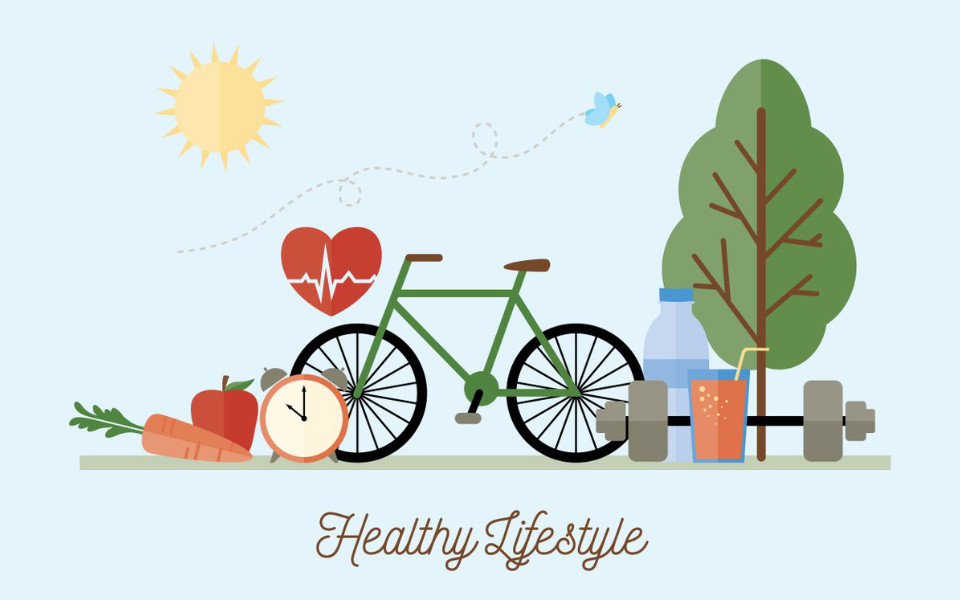In the UK, problems such as heart disease and strokes account for more than 44,000 deaths every year. What’s alarming is that these fatal diseases are all but preventable – meaning they could have been avoided with a proper diet and exercise. In other words, living a healthy lifestyle could have helped prevent these untimely deaths.
With that being said, the UK government – and many other countries – are steadfast in promoting healthy living. After all, a Harvard report has stated that healthy lifestyle living can increase your life expectancy by a minimum of 2 years – to as much as 14 years! With that being said, if you want to live healthier and longer, then you need to heed these tips for healthy living.

What is a Healthy Lifestyle?
The World Health Organization (WHO) defines healthy living as a “way of living that lowers the risk of being seriously ill or dying early.”
More than that, a healthy lifestyle can help you enjoy more aspects of life. It’s not just about the absence of disease. Having good physical, mental, and social well-being is included as well. As such, balancing these different aspects is what a healthy lifestyle is all about.
Aspects of Healthy Living
According to the same Harvard report, a healthy lifestyle is the culmination of several facets, namely:
1. Diet
A healthy diet is one that could provide you with the right amount of calories (energy) needed by the body. For women, it should be about 2,000 kcal. For men, the requirement is a little higher at 2,500 kcal.
According to the British Nutrition Foundation (BNF), a healthy living diet should include the following:
a) Fruits and vegetables
Five portions of fruits and vegetables need to be eaten every day. One standard portion is 80 grams, but for dried fruits, it is only 30 grams. Apart from solid fruits and vegetables, a portion could include 150 ml of 100% unsweetened juice or smoothie as well.
b) Starchy carbohydrates
This takes a huge chunk of your plate, as it should comprise 1/3 of the food you eat every day.
This healthy living food group includes pasta, rice, bread, potatoes, and other starchy sources. Alternatives include high fibre foods made from whole grains.
c) Proteins including fish, meat, eggs, beans, and pulses
2 portions of fish (1 should be oily) should be consumed per day. Eating red or processed meat, on the other hand, should be limited to 70 grams per day. As such, the recommendation is to go for healthier protein sources, such as beans and pulses.
d) Dairy products and alternatives
Milk and dairy product alternatives (except creams, butter, and ice-creams) should be eaten every day.
e) Oils and spreads
Unsaturated oils (except for butter) provide vitamins and essential fatty acids. However, they should be eaten in small amounts because they are rich in calories.
While the above-mentioned sources are necessary for your daily diet, there are some foods that you should only avoid. These include sweets, chocolates, and pastries (among many others), which are rich in sugar, salt, and saturated fat.
2. Physical Activity
Regular physical activity is one of the ways to keep healthy. According to the BNF, adults should perform 150 minutes or 2.5 hours of moderate-intensity activity for the week.
Physical activity is not only for adults, as it also contributes to a healthy lifestyle for kids. With that being said, children aged 5 to 15 years should have at least 60 minutes of physical activity spread throughout the day.
3. Body Weight
The ideal body weight is usually determined by the body mass index, which is the person’s weight in kilograms divided by the square of height in meters. A BMI is considered normal and ideal if it ranges from 18.5 to 24.9.
What is the Importance of Healthy Living?

There are many reasons why a healthy lifestyle is important. Apart from extending your life, living healthily can make you look and feel good. Here are some healthy lifestyle benefits for you and your family:
1. Healthy Diet
There’s a saying that goes “you are what you eat.” As such, eating healthily means you get to live better. For one, a healthy living diet allows you to enjoy the following gains:
a) Ideal weight
Eating healthy can help you achieve your ideal weight. Not only will this make you look better, but it can also make you feel better. Additionally, it can help save you from certain health problems, such as obesity, heart disease, diabetes, and stroke, to name a few.
b) Stronger teeth and bones
A diet rich in calcium helps strengthen the teeth and the bones. It can also slow osteoporosis, which is the bone loss that occurs with age.
Vitamin D rich foods are also necessary for the teeth and bones. This vitamin, which can also be channeled through sunlight exposure, can help improve calcium absorption in the body.
c) Improved heart health
A diet rich in Omega-3 fatty acids is known to help lower cholesterol and blood pressure. As such, eating such sources can help reduce your risk of heart disease.
d) Better immune system
A healthy diet provides all the nutrients that you need, including Vitamins A, B, C, E, Iron, Selenium, and Zinc. These can help boost your immunity, which keeps you better protected from infections and certain diseases.
e) Reduced risk for Diabetes
A balanced diet that focuses on fibre rich foods and whole grains can help reduce the risk of Type 2 diabetes. After all, these fares help slow the absorption of carbohydrates, which results in a more ‘controlled’ rise in blood sugar levels.
2. Regular Physical Activity
Exercise has many benefits for the body. Not only is it useful for reducing weight, but it can also reduce disease risk. Here are some healthy lifestyle facts that come with exercise, according to the National Health Services.
Exercise can help reduce the risk of…
- Osteoarthritis by 83%
- Hip fracture by 68%
- Type 2 diabetes and colon cancer by 50%
- Heart disease and stroke by 35%
- Falls, depression, dementia, and early death by 30%
- Breast cancer by 20%
3. Ideal Body Weight
As mentioned, the ideal BMI is anywhere from 18.5 to 24.9. Those who measure above this are considered overweight (25 to 29.9) and obese (30 above).
Maintaining a normal BMI will help you avoid the consequences of obesity, which include:
- Low quality of life
- Mental conditions such as anxiety and depression
- Heart disease
- Stroke
- Type 2 diabetes
- Sleep apnea and other breathing problems
- Cancers of breast, endometrium, kidney, gallbladder, liver, and colon)
- Body pain and functioning issues
- All causes of death
What Habits Are Unhealthy?

Even if you eat healthily and exercise often, some habits can lead to a poor, short life. Here are the vices that prove to be detrimental to health:
1. Smoking and Tobacco Use
It goes without saying that nothing good comes from smoking and tobacco use. However, this does not seem to stop many Brits from doing so. According to the Office of National Statistics, smoking remains to be the leading cause of preventable death in the UK. These fatalities usually stem from the following smoking-related complications:
- Stroke
- Lung disease
- Heart disease
- Diabetes
- Cancer
What’s bad about smoking and tobacco use is that its effects are not limited to the user. It can also affect others by way of secondhand smoke. According to the Centers for Disease Control (CDC), it causes as much as 41,000 deaths annually. The unfortunate recipients of secondhand smoke often succumb to several complications, including lung cancer, stroke, and heart disease.
2. Alcohol Abuse
Alcohol abuse is a global public health burden. With more than 21% of adult Brits heavily consuming alcohol, it comes as no surprise that it has led to more than 5,800 deaths per year. These fatalities often result from the effects of chronic alcoholism, which include:
- Depression
- Dementia
- Stroke
- High blood pressure
- Pancreatitis
- Liver disease
- Cancers of the mouth, head, neck, breast, and bowel
- Sexual problems and infertility
Apart from affecting you physically, alcohol can harm your social health as well. Alcohol misuse can lead to financial problems, unemployment, homelessness, family break-up and violence, and domestic abuse.
How to Start Living a Healthy Lifestyle
Living healthily, without a doubt, is beneficial for the mind and the body. As such, if you wish to live better and longer, then you need to follow these tips on how to start a healthy lifestyle:
1. Eat healthily
A healthy diet does many wonders in the body. You can get the most out of your diet by following these healthy living tips from BNF:
a) Drink well
Drinking 6 to 8 glasses of water every day can do many wonders for the body. It helps achieve the following:
- Maintains body fluid balance. Remember, 60% of the body is made of water.
- Controls the appetite. Water contains 0 calories, yet it does a good job of filling you up.
- Energizes the muscles. Drinking water is important especially when you are exercising. That’s because it helps fuel the muscles, so they don’t feel fatigued after a tough work-out.
- Improves kidney function. Kidneys need water to excrete harmful toxins in the body. Lack of water intake may lead to painful, surgery-requiring kidney stones.
- Promotes healthy bowel function. If you want to keep your bowels healthy, then you need to drink lots of water. This helps prevent constipation, allowing you to get rid of toxic digestive byproducts daily.
- Beautifies the skin. Water makes you beautiful inside out. It keeps the skin plump and hydrated, thus making wrinkles and fine lines less obvious.
While it may be tempting to drink sweetened beverages now and then, you are better off with water and its low-calorie alternatives. Good examples include organic grass-fed milk, and unsweetened tea or coffee.
b) The more fruits and vegetables, the better
As mentioned, you need to eat 5 portions of fruits and vegetables every day. If you don’t like eating them whole, you can add them to your favorite recipes. To wit, you can put more carrots and tomatoes in your spaghetti sauce.
c) Fish is fantastic
Fish, especially sardines, mackerel, trout, and salmon, are rich in several nutrients. They have high amounts of omega-3 fatty acids, which can help improve heart health. They are also teeming with Vitamin D, which allows better calcium absorption in the body.
d) Opt for whole grain, fibre rich foods
Your daily meal should always include starchy carbohydrates, such as brown rice, pasta, bread, and potatoes. However, it is best if you opt for whole-grain alternatives and high fibre foods. Better yet, avoid foods that contain processed salt and high sugar.
e) Cut down on white salt
Ideally, adults should consume no more than 1 teaspoon of salt per day. Additional amounts can lead to increased blood pressure, which may precipitate a heart attack or stroke.
A better choice for white and processed salt is Himalayan salt. It has bigger ‘pink’ chunks which are very tasty. You don’t need to use much to attain the same degree of ‘flavor.’ As such, you consume lesser amounts of sodium whenever you use Himalayan salt.
You can also use herbs, spices, vinegar, and citrus juices during cooking as they have lower sodium contents.
f) Say no to sugar and unhealthy fats – and yes to ‘healthier’ fats
Fatty meat, chocolate, and cheese may be delicious, but they can be harmful to your health. They are rich in sugar, which can ramp up your risk for tooth decay and Type 2 diabetes. They are also high in saturated fat, which can increase cholesterol levels in the body. If left unmanaged, this can clog the heart and lead to a variety of cardiac problems.
Speaking of fat, you need to know that not all of them are bad for you. There is a healthy diet that is rich in ‘good’ fats, which most people know as the Ketogenic diet. According to Dr. Mark Hyman, this ‘fatty’ diet, unbelievable as it may seem, is a good way to burn fat.
This effective diet drives the body to undergo ketosis. In this process, the ketones produced by fat, instead of carbohydrates, are used up as energy. Not only does this speed up your metabolism (and the fat burning process), it also helps keep the hunger pangs at bay.
2. Move, move, move

With the many benefits of exercise, you should aim to do physical activity every day. As mentioned, people aged 19 to 64 need to perform 150 minutes of moderate exercise weekly. It could include any of the following activities:
- Brisk walking
- Hiking
- Rollerblading
- Dancing
- Tennis
- Water aerobics
Certain chores, such as pushing the lawnmower, qualify as moderate exercise as well.
If you can, you may also opt for 75 minutes of vigorous exercise every week. This type of activity usually covers:
- Aerobics or gymnastics
- Jogging or running
- Jump rope
- Biking fast (or on hills)
- Swimming
- Sports such as rugby, hockey, or netball
- Martial arts
If you don’t have fitness equipment or a gym membership, fret not! Walking up the stairs also counts as vigorous activity.
More than just being physically active, it helps to do strengthening exercises at least 2 times a week. These can help improve several muscles, including that of the arms, shoulders, chest, back, abdomen, hips, and legs.
Good examples of strengthening exercises include:
- Pilates
- Tai-chi
- Yoga
- Weightlifting
- Push-ups or sit-ups
- Resistance band workouts
Again, if you don’t have access to necessary gym equipment, you can strengthen your muscles by doing certain chores. Lifting and carrying the kids and toting heavy shopping bags are good ways to condition your muscles. Digging and shoveling your garden can help improve several body parts as well.
High-Intensity Interval Training – HIIT
If you don’t have a lot of time to exercise, know that it’s no longer an excuse to skip a workout. You can get the exercise that you need in as short as 10 minutes with high-intensity interval training, also known as HIIT.
This popular workout involves brief yet very-high intensity bursts of cardio. They are then followed by equal, if not longer periods of rest. Because they can be done very rapidly, HIIT can be completed in as short as 10 minutes.
With studies saying that it’s even better than traditional aerobics, HIIT is a fast and effective way to maintain a healthy lifestyle.
3. Avoid being sedentary
More than just exercising daily, it is best to reduce sedentary behaviors such as sitting or lying down for long periods. After sedentariness could increase your risk of obesity, heart disease, and Type 2 diabetes, to name a few. As such, you must follow these move-about tips for a healthy lifestyle:
a) Multi-task
Instead of sitting on the couch while watching TV, why not bust out some moves while you do so? Using your treadmill or making lunges can help you burn calories – without missing out on your favorite TV show.
b) Walk
If you live near to the office, maybe you can try to walk or ride a bike instead of driving or commuting to work. Not only is it good for health, but it can also help reduce your carbon footprint.
Another option is to park farther away from the building entrance. This will force you to take a few steps before and after work.
c) Take the stairs
Unless your office is on the 30th floor, you can try to take the stairs (instead of the elevator or escalator) when going to work. Remember, taking the stairs burns more calories than jogging per minute!
d) Stand
If your work entails much sitting, then it’s best to take a stand – quite literally. Standing uses more muscles, and as such it helps burn more calories in the body. You may try working on standing desks, which are good for you (and your office mates’) health.
e) Out of your chair!
Want to talk to your co-worker? Instead of sending a private message or an e-mail, why not walk over to your officemate? This will not only help you burn some calories, but it can improve your social health as well!
f) Get NEAT
NEAT refers to non-exercise activity thermogenesis, where calories are burned outside of exercise, sleeping, or eating. The best strategies to achieve NEAT including bending, turning, and stretching.
4. Don’t smoke or use tobacco
Quitting smoking may be a tough task to do, but you should do so. After all, it provides a bevy of healthy lifestyle benefits.
According to the CDC, it can help reduce the risk of heart disease in as little as 1-2 years after quitting. It can even prolong your life, as non-smokers get to live 10 years longer than smokers. Who doesn’t like an additional decade of happy, healthy living?
5. Don’t drink alcohol
Alcohol is not only an expensive vice, but it can also lead to chronic and fatal conditions. As such, it is best if you don’t consume alcohol at all. Studies show that it can shorten your life expectancy by a whopping six months! If you want to live a healthy lifestyle, alcohol should not be a part of it.
Wrapping Up
A healthy lifestyle is more than just having good physical health. It includes your mental and social well-being as well.
Several factors help contribute to a healthy lifestyle. One is a proper diet. Healthy fares help promote overall health – and prevent the risk of certain diseases.
Second is regular physical activity. According to the NHS, doing 150 minutes of moderate exercise or 75 minutes of vigorous workouts weekly can cut the risk of certain diseases by as much as 83%.
Third is maintaining an ideal weight, which in BMI terms range from 18.5 to 24.9. Preventing a sedentary lifestyle can help reduce weight gain and obesity, both of which may lead to a variety of health conditions.
Fourth is avoiding smoking or tobacco use. After all, this remains to be the leading cause of preventable death in the UK. Quitting smoking can help reduce the risk of heart disease 1-2 years after. More so, it can add as much as 10 years to your life!
Last but not least is zero alcohol consumption. Apart from wreaking havoc on the body, it can lead to social ills such as money problems, unemployment, even domestic violence. It can even decrease life expectancy by as much as 6 months.
With that being said, a healthy lifestyle is best achieved by balancing these factors. It may be hard at first, but you can do so eventually with the help of the healthy lifestyle tips mentioned above.

